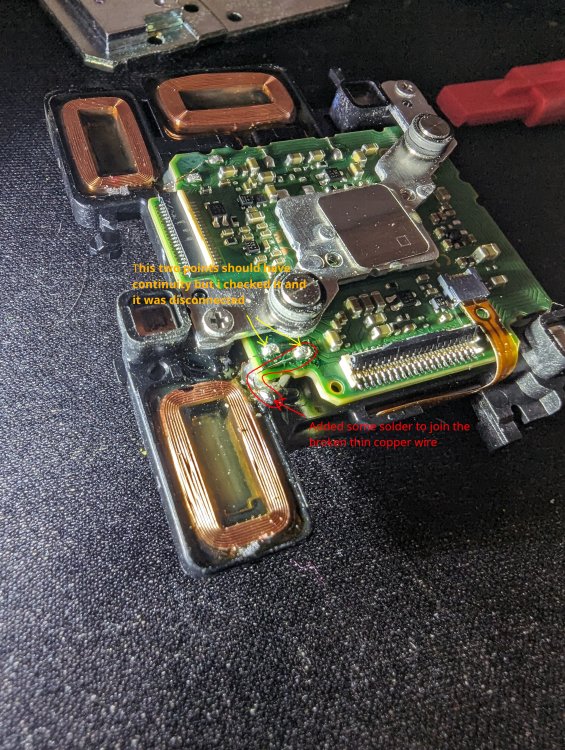Leaderboard
Popular Content
Showing content with the highest reputation on 04/19/2024 in all areas
-
Color - SOOC vs. LUTs/Grading
eatstoomuchjam and 2 others reacted to mercer for a topic
To be fair, I vaguely remember the OP stating at some point that he/she likes to have discussions about gear. And let's be honest, this forum is primarily a gear forum. Perhaps the OP should mention that this discussion isn't necessarily about a decision he's currently planning on making and instead it's about learning and gathering information. With that said, @kye has a fair point. These cameras are only tools for creative endeavors. These cameras will not make the film or color grade your film or make your film good. At the end of the day, story is king. I would suggest to the OP that they take some time and go back and look what people were creating when the DSLR revolution began. Look at t2i and GH2 videos to see what was possible with limited resolution, DR and resources.3 points -
I highly recommend going to the source if you're interested in going deeper, here are a couple of interviews with Jill on Joker that I found to be fascinating and thought-provoking: ...and this interview with Jill on John Wick and other films where they even talk about specific shots etc: Lots of info out there if you search and go looking for it 🙂3 points
-
3 points
-

Color - SOOC vs. LUTs/Grading
eatstoomuchjam and 2 others reacted to kye for a topic
Here's my recommendation for SOOC shooting - Sony AX100. As Dave says "Sony AX100 looks better than your camera". Just look at the nice contrast, saturation, and above all... skintones! and in mixed lighting no less! Good luck getting that with a "better" camera - they all have far too much DR to give you a punchy image from their 709 LUTs or profiles.3 points -

Joker 2 - Color Breakdown
Tim Sewell and one other reacted to MrSMW for a topic
It’s not just because the B&W makes it ‘arty’. The script is great, taking what was originally a book, then a French film, then the well known Matt Damon movie and now an 8x near 1 hour episode series. The acting is great. The cinematography IMO is superb. I have zero criticisms of it and that is rare for me.2 points -
Color - SOOC vs. LUTs/Grading
ghostwind and one other reacted to eatstoomuchjam for a topic
One of the reasons that people are getting frustrated is that you're "asking basic questions," but then basically ignoring a lot of the answers. It's like you keep asking what saw makes the best cabinets. When people tell you that you need more than a saw, you start asking people to compare brands of saws. Which cameras has the best color and in-camera noise reduction? All of them. Also, none of them. Go to NAB and ask 100 people on the floor. Every one of them will be completely correct. Every one of them will be completely incorrect. How do you know? Ask almost any of the others. It is also a bit frustrating that you are asking questions that seem like you are trying to choose which camera to buy and after you receive a bunch of answers, you shift your focus and start asking again. If you want somebody to yell at you about which camera has the best colors, go to YouTube. There are dozens of people shouting about how the camera that they bought is the best camera ever. Then just try to ignore the other videos from all the people saying it's the worst camera ever. Heck, there are already dozens of videos just about the Pyxis talking about how it's the best camera released in years or the most ho-hum camera announcement so far this year. Bonus: almost none of the people with those videos has even seen a Pyxis in person, much less actually shot with one.2 points -
Same! The color really brought us into a different/alternate universe!2 points
-
Color - SOOC vs. LUTs/Grading
eatstoomuchjam and one other reacted to SRV1981 for a topic
I just realized - I did come to the wrong forum. I just assumed this was a wider community than what actually is. Many view themselves as filmmakers. I do not, I’m sure there’s other forums/places to chat just about equipment etc and not ruffle weathers of those who see themselves as “filmmakers”.2 points -

Joker 2 - Color Breakdown
kye and one other reacted to Tim Sewell for a topic
Actually unreservedly loved it. I'm finding that I'm gradually getting further and further away from preferring verite/realistic looks and getting into the wilder end of things!2 points -

Joker 2 - Color Breakdown
eatstoomuchjam and one other reacted to kye for a topic
I'm just wondering why you were posting a random YT video. If I posted a new thread with every video I liked then the place would just look like my YT viewing history and not a forum where discussions can happen and people can share knowledge etc. I don't know what experiences you had in high school, but I've been an adult a long time and I've become fond of talking to people. I really don't know what you were trying to say? What point were you trying to make? Maybe if you actually typed something then there might be some communication....? There are all sorts of interesting things in that video, so the discussion could be a good one. Let's all leave high school behind and try and discuss things like adults 🙂2 points -

Shooting a short
eatstoomuchjam reacted to Tim Sewell for a topic
So there's a guy who lives near me - young guy, good looking - who 2 years ago gave up a film-making degree at a London university (can't remember which one - but a good one, I can remember thinking when he told me) to go on the tools with his dad, because he couldn't see any way that an expensive 3 year course was ever gong to wash its face. Was talking to his sister this evening and she reckons he'd be totally up for getting involved in my short. Which could mean I've either got talent that isn't me, or a camera op that isn't me. Either way, it suddenly makes this project a whole lot easier. (Not to mention Resolve 19 - which changes the space entirely!)1 point -
Didn't know that was in B&W. Thanks for the heads up. I adore B&W, so much so that I've been testing my FP in 4K 8bit mode for the sole purpose of having a smaller set up for a B&W film.1 point
-
Yep, every time I invest in one, it ends up being too much for my use case. Too much cost, battery charging, transport, set up, storage etc. Just a PITA. No longer and never again!1 point
-

Joker 2 - Color Breakdown
Tim Sewell reacted to MrSMW for a topic
And the utter lack of it has me admiring Ripley on Netflix right now. I’m partly thinking the Amalfi coast should be in colour, but the rest is definitely working for me as a B&W production. Of course it would look shite if the coastal stuff was colour whilst the rest was B&W but chapeau on this 8 parter, I think it’s great. Sorry it’s not a Joker II comment 😛1 point -
For general video, I prefer a small amount of 'float' in the stabilisation - it looks more natural. For handheld or monopod long telephoto video, I need all the stability I can get, so it's Panasonic 'IS Boost' or Oly/OMDS '+1' level stabilisation in that situation for me.1 point
-
Literally a non-controversial, non-trolling, basic question that you can partake in politely or not.1 point
-
Not really, I've asked basic questions for discussion purposes but the elitism and condescension as your post demonstrates is strong here - i'd rather just find a place with more amateur enthusiasts rather than certain folks who think highly of themselves1 point
-
Not at all surprised - doing that is far more complex and creative than the simple documentary stuff I normally produce.1 point
-
I'm not familiar with the GH5v2 but Panasonic was (at that time) updating cameras with all the user-feedback, and your description was certainly things that the community was wanting. I definitely agree that one of the main challenges is taking a clip that was shot in LOG and has 10-14 stops of DR in it, and somehow stuffing that into Rec709 which has just over 5 stops of DR. This obviously manifests in having to crush or severely compress various areas of the luminance range, but it also means that the source material can have colours that are dramatically more saturated than Rec709 can contain and you'll need to work out how to contain those too. Once you have enough DR to shoot the scenes you need to shoot, having more is actually a liability rather than a feature. I co-produced a 5-min short with my sister a long time ago, and we estimated that all up it had 10,000 person-hours in it. But enough of this blasphemous film-making talk - we should go back to talking about camera colour profiles like film-making doesn't exist!1 point
-
The thumbnail of the XH2s and the profile picture of the guy look IR heavy indeed. It seems like he actually likes this look.😊1 point
-
I've been mentioning this before,that I found the GH5 much easier to grade than the S series. It has 709 as colour space vs V-Gamut on the S cameras, also two to 2.5 stops less dynamic range. For lit scenarios I was very fine with the full curve and gamut as contrast and color was much more stylized and designed. The GH5 in MK II alteration is still a camera I wanna check out with its creamy high resolution image. It's more classic and organic compared to the crispier image of the MK I. I have only seen one person ever with the MKII. It has 10bit in 60p 4K as well. And from the Mark I the beloved S16 crop or optional 2/3" mode via 2x digizoom. Is the latter without heavy aliasing and moiré on the GH5? @kye1 point
-

Joker 2 - Color Breakdown
SRV1981 reacted to Tim Sewell for a topic
I watched this yesterday and it inspired me to watch the first film (only 5 years late!). It's unusual to see Waqas quite so excited about something but it was an excellent view into the art, rather than the technique, in top-end colour grading.1 point -
Looks like it's only a problem with the nisi vnd1 point
-
Panasonic S5 II (What does Panasonic have up their sleeve?)
j_one reacted to Llaasseerr for a topic
I had a chance to test this, it does look like the extra green shadow noise introduced by the new autofocus is somewhat reduced by shooting at the higher base ISO 4000 if the situation allows for it. So shooting with an ND could work.1 point -
I especially love the second shot. @mercerLooks fantastic. I have not come around filming anything for almost a year now unfortunately. All my colabs have moved themselves into the shady hideaways of oblivion and my aspirations to be a full time crewmember have been very low after my accident I had on a job. But your posts are some of the very few on this forum which inspire me to start filming again. S35 is fine for me on my S1H btw.:) Also waiting for some more fine reads from @QuickHitRecord 😊1 point
-
I had a faulty GX80 showing me a message a few seconds after power on: "Please Turn Camera Off and Then On Again". I knew it was the ibis failing because only one part of the sensor was static and the other part was very wobbly. So I dismantled my camera following this tutorial until I reached the 10th step. Once I had the ibis+sensor out of the camera, I only had to remove 3 screws and to separate the 2 flex of the sensor. Then, I realized one of the tree electromagnets had no continuity, and added some drop of tin to join the broken copper wire. And it's fixed and working again. I am so happy! I include an image of the point that was failing1 point
-

Sony vs Canon colour science - does this explain the difference?
SRV1981 reacted to theSUBVERSIVE for a topic
From a presentation I watched from Alister Chapman I got to understand - not fully - a few things about colour science, logs, sensor, etc. with my own take on it since he wasn't talking about this specifically. He basically explained the differences between broadcast standard, how to use the extra stops you get in these cameras and how log works. I think that the sensor itself is less important to the discussion because that's just a workspace, two manufacturers or more can use the same sensor and have very different results in the end. Colour science does matter, I can't agree with those that say like "it doesn't, you just have to grade better", that makes zero sense. Actually in the presentation Chapman said something similar to Andrew's theory, Sony is an engineer company and they make it so you can get the most color gamut possible, therefore, they get more green as well, which not necessarity means it will make better images. But that's just one step, the other one is how you use it. He also talked about how the green end up shifting to fit the workable color gamut and he even explained the difference between S-log 2 and S-log 3 in more details and why S-log 2 is more complicated to grade or why you record S-log exposing to the right, about 60% zebra. When you create a log or a picture profile, cine gamma, etc. that's when you start to use the information you have from the sensor and in this case, simply showing all the color gamut is not really the best option and that's when colour science comes. I don't know if I would use the word artistic here, but more like perception, so making the data you get into something that looks more natural to our perception does make a lot of difference, even more because during color grading you will be doing something similar. But let's say that after the data you get, you make something unbalanced because you wanted to show all the color gamut possible, then it will be much harder to get a more natural look since you will be getting more green and depending on several factors like color space, compression, etc. you might not be able to get what you would had you created a more balanced log with a better colour science. So basically with a better colour science you make a better use of the data you can get from the sensor, it doesn't necessarily mean showing more colors or even scientifically accurate colors. Of course that also means it's subjective as well and there is no a right and worng exactly, but overall, when the difference is notable you can say that one colour science is indeed better than the other and when it's closer, then it becomes more of a personal preference. That's probably also why you have a big difference between measurements of stops, color gamut, etc. and practical, real life aplication because measurements don't really tell how you use it and that's also why those DxO ratings don't mean one camera is better than the other. - As for why the S-log 2 is harder to grade, in simpler words it's something like it's more curved than S-log 3. When you grade usually you will do it based on that middle and the S-log 3 from that part and above is more like a line and less like a curve, so when you grade it up or down, it's more uniform. With the S-log 2 you have to basically grade the shadows, middle and highlights separedly because if you do based on any of these 3 parts, the value you add or substract will be different in the other section, so it's not uniform. That also matches the info I got watching a Sony guys talking about S-log 2 S-log 3. He said that S-log 3 is easier to grade and that S-log 2 is better for highlights while S-log 3 is better for shadows and if you look at the curves you can understand why, S-log 2 has more values for highlights while the S-log 3 has more values for shadows and mid tones. I think that "better" is not really the word, it's more like more nuances. Chapman also talked that in 8-bit codecs if you really want more information, you better off with S-log 2, if you want something easier to grade you can go to the others gamma curves. He explained why in low light you DON'T USE S-log at all, which totally makes sense, unless you are at night but filming a lot of light, recording in S-log will only make it noisier because although you will be getting more data overall, in the areas that matter it's the opposite, making is much noisier and that's also why S-log is no good for chromakey as well.1 point -
good point ! That would make sense as I have seen in an interview a samsung rep saying that you can play the nx1 h.265 files on their tv's. Could be why they chose h.265 & their vivid color science1 point
-
Back to the original subject of the thread: Andrew has a point that Canon cameras produce more pleasing/aesthetically appealing color than Sony (and Panasonic and Samsung, for that matter). But I don't believe that this has to do anything with sensor tech respectively color gamuts. After all, Nikon produces pleasing color, too, but uses Sony sensors. We shouldn't forget that 8bit video - i.e. the signal recorded by Sony A7 cameras, most Canon C-series cameras, Samsung NX1 and Panasonic GH4 internally - represents only a fraction of the sensor's color information. In the case of 14bit sensor signals, 8bit video only contains 1/64th or 1.5% of the original color information, in case of 12bit sensor signals, only 1/16th or 6.2%. (You might argue that debayering isn't factored in here for the 12/14 bit signal, but on the other hand, 4:2:0 chroma subsampling isn't factored in for the 8bit signal either.) So it's all about which choices the jpeg/mpeg engine of the camera makes: which 98.5%/93.8% of colors it will throw away and which it will keep. Cameras by consumer electronic manufacturers seem to be biased towards keeping a lot of green channel information because it will result in images that the untrained eye will perceive as sharper/more detailed. (The human eye can see greens better than other colors, a product of evolution and the age where hunters and gatherers need to spot prey or enemies in the woods.) It's probably the color science equivalent of edge sharpening, chroma oversaturation and increased micro contrast that is commonly used in consumer/amateur cameras to make images "pop" and appeal to the average consumers. We shouldn't forget that Sony, Panasonic and (still) Samsung produce affordable consumer 4k cameras to boost sales of their 4k flatscreen TVs. I wouldn't be surprised if their color sciences is optimized for those TVs rather than for professional or cinematic/photographic video production.1 point
-
Sony vs Canon colour science - does this explain the difference?
SRV1981 reacted to austinchimp for a topic
true, and after working extensively with the original A7s, Red raw and now the Canon 1DC I can confirm that they all need skilful tweaking straight out of the camera. The difference for me has been that with Canon and Red files the first hour or so of grading is correcting the colour (removing weird casts, exposure, getting skin in the right area, making it look natural) and then I can go onto working the general look and feel. Where as with Sony - in any colour profile you choose - the first stage of 'fixing' the image so that it looks natural never really ends. I find it very hard to ever reach a point of having a natural look I'm satisfied with, and then any additional change I make to the image tends to knock all my previous work out of whack. With the Canon files, once I've got it to a natural, neutral point, further creative grading seems to go much smoother and doesn't stray out of a natural getting image as much. What I'm basically saying is that in my workflow Sony A7s footage requires me to constantly wrestle with the image to stop people looking like aliens or zombies, whereas in Canon footage I can push and pull the image much further while people tend to remain looking like people. As a working pro those hours saved and reduced stress is hard to put a value on. as an idiot, I greatly appreciate this!1 point -

Sony vs Canon colour science - does this explain the difference?
SRV1981 reacted to Michal Gajdoš for a topic
The color is not a physical property of any object, it is only subjective to our mind. What we are used to. There is zero science to your claims that Canon has "better" colors, there is no "better" color. A certain color you might find pleasing, is disgusting to others. Just as stated here: On the other there are also articles saying the opposite, like this one : http://web.mit.edu/abyrne/www/ColorRealism.html, but as they say it works only to a certain degree. However it is important to note the difficulty of creating a nice look with the sony's S Log compared to baked colors of Canon straight out of camera. Personally, I don't care if canon has almighty color, if those grandpas cannot give me simple stuff like focus peeking or articulated screen (what is the almighty color shot to me if it is not in focus and my back is crying in pain) to more sophisticated stuff such as slow mo, better DR, better sensor etc. etc. etc. If only we could combine best of both worlds1 point -

Sony vs Canon colour science - does this explain the difference?
SRV1981 reacted to TheRenaissanceMan for a topic
To answer the question in the article: No, not really. Canon's color space is just more idiot-proof than Sony's.1 point -
The IBIS in my beloved GX80 just broke!
kye reacted to projectwoofer for a topic
Hey there! Bad news, I’ve just realized the the IBIS in my GX80 camera doesn’t work as it should anymore. 😫 I bought the camera new in 2018 and I just noticed today that when I shoot a video the IBIS seems to be working correctly for 3-4 seconds and then it starts an awful jittery movement without me doing anything. Same thing on video and photo modes. Even if I turn off the IBIS it can still do those jittery movements but maybe a bit less pronounced. At first I thought I got some problem keeping my hands stable when I realized it does that also when sitting still on a table. It’s as though I was trembling when holding the camera. Anyone had such a problem with theirs? I’m afraid that a repair could cost more than a new camera?0 points -
Instead, people respond to posts that weren't written and proselytize and talk down. It's pretty pathetic.-1 points



